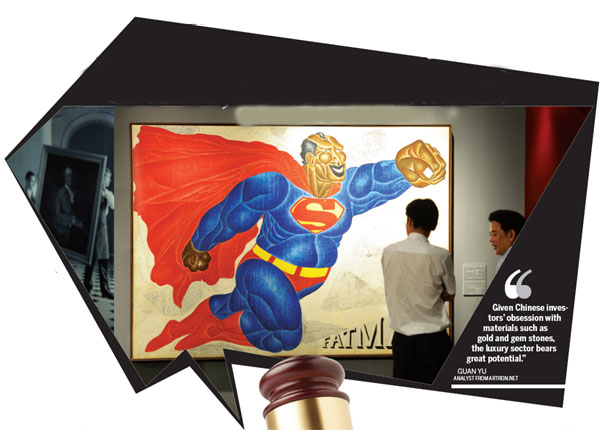Game, gavel ... guanxi?
Updated: 2013-09-27 07:01
By Emma Dai(HK Edition)
|
|||||||
Foreign auction house Christie's held its first auction on the mainland last night. The brand boasts pedigree, but can it get close to local collectors and hurt the competition. Emma Dai reports.
Never mind China's recent economic slowdown and Beijing's recent austerity drive, having waited so long to get its foot into the nation, British auction house Christie's - the first international auction house licensed to operate independently on the mainland - went out of its way to make an explosive entrance. The last hammer of its first auction fell at 8:31 pm last night, having realized 146, 270, 000 yuan ($23.90 million) on artworks which included a gunpowder-lit painting created by Chinese artist Cai Guoqiang the previous day, which sold for 15 million yuan. A ruby and diamond necklace sold at 18 million yuan was the most expensive item of the night.
CEO Steven Murphy who describes Christie's arrival in Shanghai as being a "watershed moment", was exuberant. "We look forward to engaging with and inspiring more talented Chinese artists through our business and operations, and introducing more Chinese contemporary art to the global stage," he said. His choice of the word "contemporary" was apt, given recent developments on the mainland, which serve as reminder that no matter how vibrant Christie's auction, they and competitor Sotheby's, can't expect to get it all, or gavel it all, their own way in China.
Fresh buzz was brought to mainland art-auction circles on August 26, when word came that the State Council, the central government's cabinet, submitted a proposal to suspend the Law on the Protection of Cultural Relics on transactions within the Shanghai Free Trade Zone (FTZ). That raised hopes that foreign-funded companies would soon become authorized to sell treasured Chinese antiques - the ones made before 1911. Not only that, the amendment also applied to works of modern Chinese masters, another area of much desired but forbidden fruit for the auction houses. "The ground-breaking move came unexpectedly fast," said Ji Tao, the general manager at Beijing-based Tenwin International Auction. "The wolves are coming."
The comment however, was premature and in the end, Christie's and international rival Sotheby's hopes, came down with the soul-destroying clatter of rare porcelain hitting the floor. It took just four days for the State Council's proposition to be killed by the National People's Congress Standing Committee at the close of its annual meeting. The final blow came almost as a shock. Chinese lawmakers had already rubber-stamped three other laws concerning easing restrictions inside the FTZ that same day.
Old hands may not be greatly dismayed. "In France we waited 56 years for the law to allow us to organize auctions," said Franois Curiel, president of Christie's Asia, with a rhetorical Gallic shrug. "The French laws all dated back to 1586. So I'm sure in China things will go faster."
Protectionism
But not so fast. The door to the house of mystery opened only briefly, and just wide enough to bedazzle outsiders with the treasure that awaits. Then it was shut again.
"At this moment, the market in China is not an easy one for foreign houses," said Guan Yu, analyst from artron.net, the country's leading art market observer. "They will bring only a little pressure to their domestic competitors in the short term. They (the foreign houses) need time to settle down and warm up. Their long-term performance is hard to predict. The market is so highly sensitive to policies."
Like all foreign businesses before it, Christie's will find patience a virtue in China. "The defeat of the (State Council) proposal is a sign that the authorities are not prepared to open the art auction market fully," she said. "Not yet. Protectionism is quite legitimate. All the other businesses opened step by step too, after we joined the WTO.
"Whether to allow foreign auction houses to sell cultural relics is not a simple decision," she added. "First of all, there are concerns about the protection of Chinese national treasures. In addition, the current regulatory system has a lot of loopholes, such as we find in the Auction Law. It will take some serious mending before the market can be fully opened up. There need to be thorough discussions on several topics. To what extent should the authority to sell cultural relics be given to foreigners and if so, should foreigners enjoy the same rights as their Chinese peers? Lots of questions like that need to be answered. We must not move in haste. It could lead to chaos. The message has been sent however. Opening up already is on the agenda. It's only a matter of when."
There is no controversy, however, over why the proposal is at the center of the storm. The discussion revolves around traditional Chinese painting and calligraphy. Antiques such as Song porcelain and Ming furniture are involved, along with masterpieces of a list of modern Chinese artists, after 1911.
According to the 2012 art market report jointly published by artron.com and artprice.com, top global market information provider based in France, Chinese traditional and modern paintings are the shiniest apple in the eyes of Chinese collectors since the country started becoming rich.
According to the report, $8.458 billion was spent at art auctions in China last year. Chinese Fine Art - a category which includes fine Chinese painting and calligraphy, oil painting and contemporary art - accounted for $5.068 billion, or 59.93 percent of sales. A total of 139,676 Chinese paintings and calligraphy works were sold for $4.323 billion, representing 85.3 percent in the fine art category, compared with 14.7 percent of oil paintings and contemporary works. On the 2012 Chinese Fine Art Top-100 list, 76 works are traditional and modern Chinese paintings.
In addition, the category of fine Chinese ceramics and works of art - all kinds of antiques other than painting - generated $3.255 billion sales, representing 38.49 percent of the market. Luxury items were only 1.58 percent.
About face
While in New York and Hong Kong, Christie's and Sotheby's are mounting dazzling auctions with Shang ritual bronze vessels, Tang sancai pottery, Ming masters' calligraphies, and Qing Empire bowls, their mainland catalogs are quite different. At its first mainland sale in Shanghai last night (Sept 26), Christie's mounted a collection of French wine, Kashmir sapphire, Swiss watches, Chinese contemporary paintings, a model of British architect Thomas Heatherwick's UK pavilion at the Shanghai 2010 Expo, and works from Western masters such as Picasso, whose Homme assis fetched 9.6 million yuan last night. Sotheby's sale, scheduled in December, will also feature contemporary works.
Sales networks remain the key, even in the auction trade. "Foreign auction houses are not close to collectors. That's their soft spot," said Guan. "It feels high-class but there is also a sense of distance. Their relationship stays on a business level. In terms of influence and relationship marketing, they can't compete with local businessmen, who may know collectors they met decades ago. Guanxi and face matter."
"Besides, foreign auction houses are not as good at finding new customers," she added. "The mainland market is at an early stage with only a small group of people. But the threshold for attracting new collectors is high, since this is not real estate or car sales - it requires confidence. People usually start collecting with friends they trust. While local houses enjoy strong networks through word of mouth, foreign houses still need to work on that."
But even without the favorite policy, China is still a rich mine. "The market share of luxury sector, including watches, jewelry and wine, is growing," said Guan. "Given Chinese investors' obsession with materials such as gold and gemstones, the luxury sector affords great potential." The chance for foreign houses looks good. While mainland competitors are testing the water, Sotheby's and Christie's are already front-runners in these fields. "They have good reputations and sourcing power," Guan said.
Meanwhile, Western arts are picking up. "Some collectors even turned their antenna to royal furniture and decoration," said Guan. "The price gap between Chinese and Western artworks is narrow. Works of some iconic artists, not their magnum opus, are even cheaper. That's attractive." But education is a big barrier, as Western art history is not part of common knowledge in China. "On the bright side is that when there are good guides, collectors are eager to learn," she added. "Besides, it's critical to build up market confidence. Collectors need to believe buyers are always there whenever they want to sell. That will take some time, given the country's small involvement in global market."
Contact the writer at emmadai@chinadailyhk.com


(HK Edition 09/27/2013 page6)